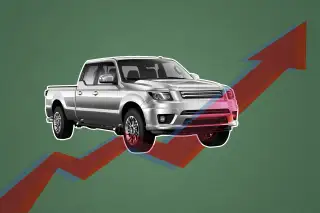Sticker Shock! A New Car Costs $5,000 More Than a Year Ago, on Average

If you’re heading to the auto dealership — well, maybe just don't. But if you absolutely need to buy a car now, you should expect to shell out a lot more than you would have this time last year. In fact, you may need to pay nearly $1,000 above sticker price for a new ride.
The average price for a new vehicle soared to a record high of $46,036 in October, according to Kelley Blue Book data released today. This is the first time the average new car transaction price has exceeded $46,000, says Cox Automotive, the parent company of Kelley Blue Book.
“Supply continues to be very tight in both the new- and the used-vehicle market,” Jonathan Smoke, chief economist at Cox Automotive said via the company website Tuesday. “Very strong demand is leading to one negative — and that is continued higher prices.”
October’s surge marks the seventh consecutive month of vehicle price spikes. Analysis from Cox Automotive suggests that supply shortages are to blame, at least partly. The global microchip shortage is causing automakers to focus on manufacturing higher-end vehicles with better profit margins, such as luxury SUVs and pickups.
“As a result, volumes are depressed, but sales revenue has jumped significantly,” the report says.
In other words, auto manufacturers don’t have enough computer chips to make their normal lineup of vehicles. So they’re channeling their limited resources into making more high-end models, which is driving up the overall price of new vehicles.
The strategy is working out fairly well — for automakers. For you? Not so much. On the lot, you’re likely to encounter slimmer pickings and higher price tags.
What’s more, normal car dealership discounts have disappeared. Average new vehicles sold for 2% above the MSRP (manufacturer's suggested retail price, aka sticker price) in October. Translation: buyers in October were shelling out $800 above the sticker price, on average.
How much are car prices up in a year?
Year over year, new vehicle prices are up $5,266 — meaning last October, you would’ve likely paid $40,770 for a new vehicle, on average.
Just two months ago, you would’ve likely paid $45,126 for a new car. Now, you’ll pay $46,036 for the average new vehicle and $61,020 for the average luxury vehicle.
And those prices aren’t likely to dip for quite some time.“The Kelley Blue Book team is expecting little relief from high new-vehicle prices in the foreseeable future, as new-vehicle inventory is expected to remain tight through the first half of 2022,” the company says.
If that wasn’t enough to dissuade you from buying a car right now, consider the ballooning price associated with ownership. Factoring in maintenance, car insurance, registration and fees, skyrocketing gas prices, depreciation and other associated expenses, owning a vehicle will set you back about $10,000 a year.
Buying a used car is often a smart way to save, when supplies are steady and market conditions are normal. But prices for used vehicles have skyrocketed lately — up 26% year over year, versus a roughly 10% increase for new cars, according to the latest Bureau of Labor Statistics report. According to new data Money obtained from Edmunds, an automotive research firm, the average price of a used car last month was $28,607, up from $22,454 October 2020, which is an increase of 27.4%.
Just before Labor Day of 2021, Money wrote that it was the worst time to buy a car. We stand corrected. Now, it’s officially worse.
More From Money:
Best Money Moves for November 2021
People’s Savings Are Plummeting to Pre-Pandemic Levels — and That’s a Good Thing